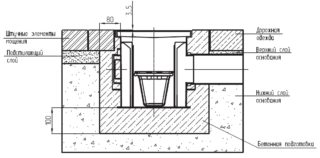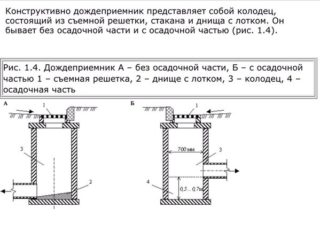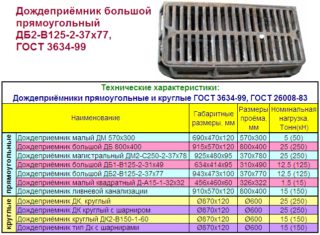Large storm water inlets made of cast iron (DB) are able to withstand increased mechanical stress. They are resistant to temperature extremes and chemical reagents that are used to sprinkle roads against glaciation. Due to their durability and resistance to combustion products of car engines, they are preferred for installation on highways.
Purpose of the inlet
The advantage of a storm water inlet is that it collects water not only from gutters located on buildings, but also directly from the surface of the earth. Where there are such structures, there are no puddles.
The DB structure consists of a case and a lattice covering it from above. The functions of the last element are as follows:
- delay of large-format debris and leaves on the surface so that they do not clog internal communications;
- upgrading of sewer drains;
- protection of pedestrians and animals from injury.
Large rectangular rainwater collectors are mounted in trays of highways or parking lots where the slope is greater than or equal to 0.005, or in areas with a gentle slope. Sometimes in such places they also put round storm water inlets, but they are less popular due to the complexity of the installation.
DB grids in the shape of a rectangle have a volumetric drainage area and are capable of receiving a greater amount of natural precipitation over a certain period. They are easier to fasten and more tightly adjoin the edges of the storm water inlet. They can also be interconnected to form a row and create a one-piece drainage system.
Specifications
Cast iron rectangular storm water inlets belonging to the DB type are of two varieties: DB1 and DB2. Structures of the first type are suitable for equipping parking lots, construction sites and industrial facilities. Devices of the second type are usually placed along highways.
The dimensions of cast-iron storm water inlets of the DB type are regulated by GOST, but may vary slightly according to the manufacturer's specifications. The most popular are products with the following characteristics:
| Type of rainwater collector | Dimensions (mm) | Weight, kg) | Maximum load (t) | Price (in rubles) | |
DB1 | Model 1 | 915x570x120 | 107 | 15 | From 3500 |
| Model 2 | 846x496x90 | 80 | 12,5 | ||
DB2 | Model 1 | 975x509x120 | 125 | 25 | From 5500 |
| Model 2 | 990x500x120 | 121 | 12,5 | ||
Models differ not only in size, but also in the maximum load due to reinforcement. DB-storm inlets are distinguished by the minimum width of the longitudinal support section of the hull, which is adjacent to the curb part of the track.
The main advantages of structures include high strength, the ability to easily withstand serious loads, durability and practicality, and a laconic appearance. The disadvantage is their severity - they are difficult to install without the use of special equipment.
Significant weight, when properly installed, prevents the product from shifting, which contributes to the safe movement of vehicles.
On the upper flat part of the grille there is a stamped symbol of the storm inlet, the year of manufacture and the manufacturer's logo. No cracks are allowed on the surface of the device. The lattice element must fit snugly against the supporting part of the frame, not swing. On the metal surface there should be no large nodules and burrs, pits. The presence of gaps is allowed, but not more than 3 mm per side.
Installation rules

The body of the storm water inlet is installed on top of the well drain flush with it. It is necessary to securely fix the frame using concrete mortar, asphalt or paving slabs. The lattice element installed in the housing must be located in the same plane with the adjacent surface to ensure the safety of people passing through it and to preserve an attractive landscape.
Devices of rectangular shape are mounted with the flangeless part of the frame to the curb at right angles to the axis of the streets.
If you place the storm water inlet incorrectly, some of the water will not drain into the device, but will flow through it, forming puddles, especially in areas with a large slope of the highway. In places where a significant amount of precipitation flows or when the slope of the street is more than 0.03, it is recommended to install storm water inlets with two grates.
Debris trapping filters require systematic cleaning. Otherwise, a stench will arise, which will be released when the liquid evaporates from the receiver.
Installation technology
Shower receivers type DB are suitable for both point and linear installation. In the first case, they are mounted near drainage points - under the roof drainage system or at the lowest point at the intersection of artificially created slopes. Through drainage nodes, which simultaneously act as a kind of garbage filters, flows from the surface enter the storm sewer.
Drainage system of linear type - an extensive network of channels located underground. Through them, surface runoff from large areas enters the rainwater collectors.
Stages of installation of the structure:
- Pits of the required size are dug with an additional increase of a few centimeters for the convenience of connecting to the general sewer system.
- An 8-9 cm sand cushion is poured into the bottom of the drain tank.
- The structural elements are lowered into the pit and covered with plywood, and then reinforced with concrete on the sides for stability.
- Plywood is pulled out, and the remaining grooves are filled with a special sealant.
The edges of the part on the surface are covered with asphalt or paving slabs. This will provide an aesthetic appearance and additional fixation of the structure.
Criterias of choice
The most important of them are:
- intensity and volume of precipitation in the territory, climate conditions;
- storm sewer area;
- terrain relief.
For an infield of a private house of small size, a rainwater receiver is suitable, which is lighter in weight and design. However, if there is a significant amount of rainfall during the year, it is better to choose the cast iron option. If a model is chosen for a place where heavy equipment passes or for an industrial zone site, the DB type storm inlets will be the best choice.
Standing out for their significant throughput and strength, the DB rainwater collectors receive and easily deliver rainwater directly to the sewer pipes. In addition, they reduce the cost of cleaning the sewage system, which makes the use of such elements profitable from all sides.











